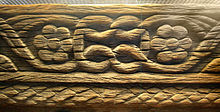
Back مملكة لولان Arabic لولان كينجدوم ARZ Loulan Catalan Loulan German Loulan Esperanto Reino Loulan Spanish Loulan erresuma Basque لولان Persian Loulan French Lèu-làn HAK
Kroraïna | |
 A carved wooden beam from Loulan in the British Museum, 3rd–4th century. The patterns show influences from ancient western civilizations. | |
| Alternative name | Krorän |
|---|---|
| Location | Xinjiang, China |
| Coordinates | 40°31′39.48″N 89°50′26.32″E / 40.5276333°N 89.8406444°E |
| Type | Settlement |
| Site notes | |
| Condition | In ruins |
| Loulan Kingdom | |||||||
|---|---|---|---|---|---|---|---|
| Chinese name | |||||||
| Traditional Chinese | 樓蘭 | ||||||
| Simplified Chinese | 楼兰 | ||||||
| |||||||
| Uyghur name | |||||||
| Uyghur | كروران | ||||||
| |||||||
Loulan (Chinese: 樓蘭; pinyin: Lóulán < Eastern Han Chinese lo-lɑn < Old Chinese rô-rân[1]), also known as Kroraïna (Krorayina) in native Gandhari documents or Krorän in later Uyghur (Uyghur: كروران), was an ancient kingdom based around an important oasis city along the Silk Road already known in the 2nd century BCE on the northeastern edge of the Lop Desert.[2][3][4][5] The term Loulan is the Chinese transcription of the native name Kroraïna and is used to refer to the city near the brackish desert lake Lop Nur as well as the kingdom.
The kingdom was renamed Shanshan (鄯善) after its king was assassinated by an envoy of the Han dynasty in 77 BCE;[6] however, the town at the northwestern corner of Lop Nur retained the name of Loulan. The kingdom included at various times settlements such as Niya, Charklik, Miran and Qiemo. It was intermittently under Chinese control from the early Han dynasty onward until its abandonment centuries later. The ruins of Loulan are near the now-desiccated Lop Nur in the Bayingolin Mongol Autonomous Prefecture, Xinjiang and they are now completely surrounded by desert.[7]
- ^ Schuessler, Axel. (2009) Minimal Old Chinese and Later Han Chinese. Honolulu: University of Hawai'i Press. p. 152, 246
- ^ Watson 1993, p. 233.
- ^ Victor Mair (May 14, 2019). "Language Log » Prakritic "Kroraina" and Old Sinitic reconstructions of "Loulan"". languagelog.ldc.upenn.edu. Retrieved 26 February 2024.
- ^ "Catalog – CKD 696". gandhari.org. Retrieved 26 February 2024.
- ^ Stefan Baums and Andrew Glass. A Dictionary of Gāndhārī – Krorayina. Gandhari.org. Retrieved 1 March 2024.
- ^ Hulsewé 1979, p. 89.
- ^ Mallory & Mair 2000, pp. 81–87.

